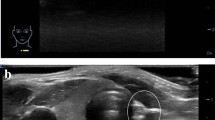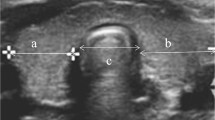Abstract
Background
Ectopic thyroid tissue as a result of thyroid developmental abnormalities is the most frequent cause of congenital hypothyroidism (CH). It is diagnosed by using radionuclide thyroid scanning.
Objective
To evaluate the sensitivity of US in the detection of such ectopias and to describe their US pattern before and during treatment.
Materials and methods
Forty-two neonates (group A; aged 11.3±4.0 days) and 33 older children (group B; aged 11.1±3.9 years) with a biochemical diagnosis of CH and thyroid ectopia detected by radionuclide scanning were evaluated before (group A) and after (group B) treatment. Thyroid US included a survey of the pathway of the thyroglossal tract and an evaluation of the location, size, echogenicity and vascularity of any tissue along this pathway suggestive of thyroid ectopia.
Results
Thyroid ectopia was detected using US in 18 patients (24%) with a similar rate during the neonatal period and thereafter on therapy. Three patients demonstrated double ectopia. These 21 sites of ectopic thyroid tissue were located at the suprahyoid level (n=12), at the level of the hyoid (n=1), and at the infrahyoid level (n=8). The maximum diameter of the ectopic tissue ranged from 4 to 14 mm. In group A (9 patients), the 11 ectopias were all hypervascular. These were hyperechoic in all but one neonate. In group B (9 patients), the ten ectopias were not vascular, and were hyper (n=3) or hypoechoic (n=7).
Conclusions
US allows for detection of ectopic thyroid tissue, but with a lower detection rate than radionuclide scanning. However, it does provide a more detailed description of such ectopias.


Similar content being viewed by others
References
Delange F (1997) Neonatal screening for congenital hypothyroidism: results and perspectives. Horm Res 48:51–61
Takashima S, Nomura N, Tanaka H, et al (1995) Congenital hypothyroidism: assessment with ultrasound. AJNR 16:117–123
De Bruyn R, Ng WK, Taylor J, et al (1990) Neonatal hypothyroidism: comparison of radioisotope and ultrasound imaging in 54 cases. Acta Paediatr Scand 79:1194–1198
Ueda D, Yoto Y, Sato T (1998) Ultrasonic assessment of the lingual thyroid gland in children. Pediatr Radiol 28:126–128
Léger J, Czernichow P (1989) Congenital hypothyroidism: decreased growth velocity in the first weeks of life. Biol Neonate 55:218–223
Chanoine JP, Toppet V, Lagasse R, et al (1991) Determination of thyroid volume by ultrasound from the neonatal period to late adolescence. Eur J Pediatr 150:395–399
Muir A, Daneman D, Daneman A, et al (1988) Thyroid scanning, ultrasound and serum thyroglobulin in determining the origin of congenital hypothyroidism. Am J Dis Child 142:214–216
Pöyhönen L, Lenko HL (1984) Ultrasonography in congenital hypothyreosis. Acta Paediatr Scand 73:523–526
Job JC, Canlorbe P, Tubiana M (1965) Decreasing radioiodine uptake during the course of congenital hypothyroidism. In: Cassan C, Andreali M (eds) Current topics in thyroid research. Academic Press, New York, pp 827–831
Léger J, Czernichow P (1990) Secretion of hormones by ectopic thyroid glands after prolonged thyroxine therapy. J Pediatr 116:111–114
Hod N, Mindlin L, Cohenpour M, et al (2002) Double ectopic thyroid. Pediatr Radiol 32:859–861
Kumar R, Khullar S, Gupta R, et al (2000) Dual thyroid ectopy: case report and review of the literature. Clin Nucl Med 25:253–254
Eising EG, Gorges R, Freudenberg L, et al (2002) Influence of therapy with iodine-131 on thyroid tissue pattern in colour and power Doppler sonography. Clin Radiol 57:646–651
Spiezia S, Cerbone G, Assanti AP, et al (2000) Power Doppler ultrasonographic assistance in percutaneous ethanol injection of autonomously functioning thyroid nodules. J Ultrasound Med 19:39–46
Lagalla R, Caruso G, Finazzo M (1998) Monitoring treatment response with color and power Doppler. Eur J Radiol 27:S149-S156
Bogazzi F, Bartalena L, Brogioni S, et al (1999) Thyroid vascularity and blood flow are not dependent on serum thyroid hormone levels: studies in vivo by color flow Doppler sonography. Eur J Endocrinol 140:452–456
Schulz SL, Seeberger U, Hengstmann JH (2003) Color Doppler sonography in hypothyroidism. Eur J Ultrasound 16:183–189
Acknowledgements
We thank Aubène Léger (Hôpital Necker-Enfants Malades, Paris) for the thyroid radionuclide scanning evaluations.
Author information
Authors and Affiliations
Corresponding author
Rights and permissions
About this article
Cite this article
Marinovic, D., Garel, C., Czernichow, P. et al. Ultrasonographic assessment of the ectopic thyroid tissue in children with congenital hypothyroidism. Pediatr Radiol 34, 109–113 (2004). https://doi.org/10.1007/s00247-003-1043-1
Received:
Accepted:
Published:
Issue Date:
DOI: https://doi.org/10.1007/s00247-003-1043-1




